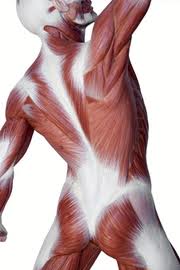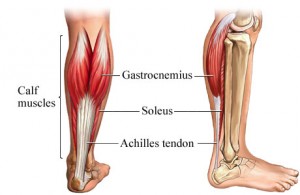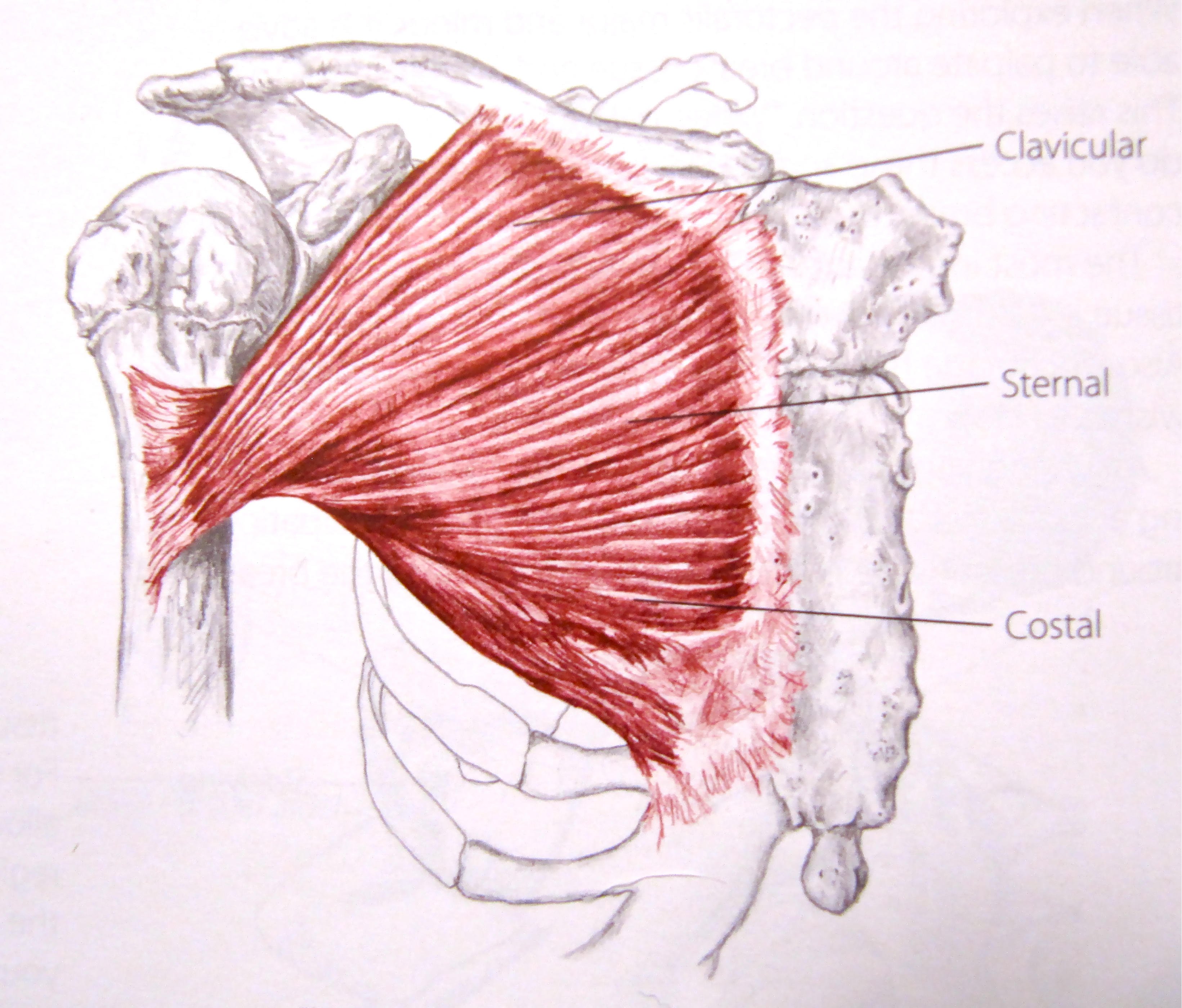by Brent Brookbush DPT, PT, MS, PES, CES, CSCS, ACSM H/FS
Fascial or Connective Tissue System:
Connective Tissue:
Connective tissue is a type of tissue in the body that supports, connects and separates tissue. One of four tissue types – connective, muscular, nervous and epithelial.
The 3 Rules (functions) of Connective Tissue:
- Fascia shapes!
- Fascia protects and supports!
- Fascia transmits force!!
Fascia:
- Connective tissue, generally referring to sheets or bands of connective tissue.
- Etymology - 1560s, from Latin fascia “a band, bandage, swathe” (see fasces). Originally in architecture; anatomical use is from 1788. (Etymology Online)
- Examples include your thoracolumbar fascia which is a sheet of connective tissue that spans from latissimus dorsi to gluteus maximus across the lumbar spine (see image below).
- Etymology - 1560s, from Latin fascia “a band, bandage, swathe” (see fasces). Originally in architecture; anatomical use is from 1788. (Etymology Online)

Notice the white stuff – that’s “Fascia” The white part on the side of the thigh is the “Iliotibial Fascia”, the white stuff on the low back is the “thoracolumbar fascia”, the white stuff between the traps is the “cervicothoracic fascia”.
Ligament
- A ligament is a short band of fibrous connective tissue spanning from bone to bone, supporting a joint.
- Etymology – late 14c., from Latin ligamentum “band, tie, ligature,” from ligare “to bind, tie,” from PIE *leig- “to bind” (cognates: Albanian lith “I bind,” Middle Low German lik “band,” Middle High German geleich“joint, limb”). Related: Ligamental; ligamentary. (Etymology Online)
- For example, an “ACL tear” is a rupture of the “anterior cruciate ligament”, a short band of fibrous connective tissue spanning from tibia to femur that supports the knee (see image below).
- Etymology – late 14c., from Latin ligamentum “band, tie, ligature,” from ligare “to bind, tie,” from PIE *leig- “to bind” (cognates: Albanian lith “I bind,” Middle Low German lik “band,” Middle High German geleich“joint, limb”). Related: Ligamental; ligamentary. (Etymology Online)

An illustration of an ACL rupture – http://orthoinfo.aaos.org/figures/A00549F02.jpg
Tendons:
- Tendons are bands of fibrous tissue connecting muscle to bone;transmitting force for movement
- Etymology 1540s, from Medieval Latin tendonem (nominative tendo), altered (by influence of Latin tendere “to stretch”) from Late Latin tenon, from Greek tenon (genitive tenontos) “tendon, sinew,” from PIE*ten-on- “something stretched,” from root *ten- “to stretch” (see tenet). (Etymology Online)
- Example, the achilles tendon transmits force from the gastrocnemius and soleus to the calcaneus (heel bone), producing plantar flexion. (see image below).
- Etymology 1540s, from Medieval Latin tendonem (nominative tendo), altered (by influence of Latin tendere “to stretch”) from Late Latin tenon, from Greek tenon (genitive tenontos) “tendon, sinew,” from PIE*ten-on- “something stretched,” from root *ten- “to stretch” (see tenet). (Etymology Online)

http://strengthrunning.com/wp-content/uploads/2013/03/Achilles-tendon-300×195.jpg
The Muscular System:
Muscle Tissue – A tissue type with the unique characteristic of being able to contract and relax
- Muscle tissue generates force!
- Etymology late 14c., from Middle French muscle “muscle, sinew” (14c.) and directly from Latin musculus “a muscle,” literally “little mouse,” diminutive of mus “mouse” (see mouse (n.)). (Etymology Online)
Another version of the “3 Rules of Muscles” lecture:
The 3 Rules of Muscles:
Muscles only contract and relax.
Muscles only work on joints they cross.
Muscles work best in the direction of their fibers.
Activity (Analyzing the Pectoralis Major) -
In this activity we will use the “3 Rules of Muscles” to determine the joint actions of the pectoralis major. In the lessons that follow we will use these same rules to build a conceptual understanding of functional anatomy – moving us beyond “rote memorization” and onto analysis, synthesis and evaluation. It is important that you take the time to understand this activity and not jump to the answer key!
- Answer the questions below
- Hints in Blue

Illustration of Pectoralis Major – http://www.natashahayden.ca/wp-content/uploads/2014/06/pectoralis-major.jpg
- Printable PDF of Questions - Pec Major Activity Sheet
- Answer Key - Pec Major Activity Answer Key
- What joint does the pectoralis major cross?
- What joint actions is that joint capable of (Make a word bank for yourself)?
- What direction (plane) do most of the fibers of the pectoralis major run?
- Highlight the joint actions that occur in that plane (Does that narrow down your choices?)?
- When the muscle shortens which directions will it pull the arm? (If you are having a hard time with this step consider your favorite chest exercise?)
- What is the name of the joint action (highlighted above) that occurs in that same direction?
- What if you raised the arm to 90° of abduction (Repeat steps 3,5 &6)?
- Do you think the pectoralis major may contribute to any other joint actions?
- Re-write your answers into one succinct table
- Check your answers.
The Nervous System:
Nervous System – The functions of the nervous system are sensory input, integration, control of muscles and glands, and mental activity.
- Nerves:
- Special cells designed for optimal transmission of an electric impulse
- Etymoglogy - late 14c., nerf “sinew, tendon,” from Old French nerf and directly from Medieval Latin nervus “nerve,” from Latin nervus “sinew, tendon; cord, bowstring,” metathesis of pre-Latin *neuros, from PIE *(s)neu- “tendon, sinew” (cognates: Sanskrit snavan- “band, sinew,” Armenian neard “sinew,” Greek neuron “sinew, tendon,” in Galen “nerve”). Sense of “fibers that convey impulses between the brain and the body” is from c.1600. (Etymology Online)
- Special cells designed for optimal transmission of an electric impulse
The nervous system may be separated into two major division by function:
- The Central Nervous System (CNS):
- Includes the brain and spinal cord, and can be thought of as the “thinking”, organizing, or regulating center of the nervous system.

Central Nervous System – http://medicalterms.info/img/uploads/anatomy/central-nervous-system.jpg
- The Peripheral Nervous System (PNS):
- Comprises the nerve cells and axons that communicate information from sensory receptors via afferent (into) nerves, and efferent (away from) nerves that communicate information to organs, muscles, glands, etc… to effect their function.

Efferent Nerves – http://www.highlands.edu/academics/divisions/scipe/biology/faculty/harnden/2121/images/plexi.jpg
A Motor Unit:
- An efferent nerve (a “spine to muscle” nerve cell) and all the muscle fibers it innervates.
- A motor unit fires maximally or not at all (the “all-or-none principle” related to “action potentials”)
- The amount of torque generated at a joint is not due to “how hard” a motor unit fires; as every motor unit fires as hard as it can once recruited. Force is increased by recruiting a greater number of motor units, or by recruiting larger motor units.
- Example, Power lifters are not strong simply because they are big, but because they practice lifting large loads and have adapted by enhancing the number of motor units they are able to recruit in a coordinated fashion (intermuscular coordination).
- The amount of torque generated at a joint is not due to “how hard” a motor unit fires; as every motor unit fires as hard as it can once recruited. Force is increased by recruiting a greater number of motor units, or by recruiting larger motor units.
- A motor unit fires maximally or not at all (the “all-or-none principle” related to “action potentials”)

http://chadwaterbury.com/wp-content/uploads/2010/12/book-motor-unit.png
What is the function of the nervous system (for our purposes)?
- Receive information from sensory afferents
- Interpret, organize & plan
- Activate motor units via efferent motor nerves
How complex does this get… well lets start with a fairly simplified definition of optimal function….
Optimal Neuromuscular Control:
- “The ability of the neuromuscular system to allow agonists, antagonists, stabilizers and neutralizers to work synergistically to produce, reduce, and dynamically stabilize the entire kinetic chain in all three planes (National Academy of Sports Medicine).”
… and that’s just the beginning
Activity: Putting it all together -
In this activity we tie all of the tissues we’ve discussed together.
- Fill in the blanks in the paragraph below
- Word bank below
- Printable PDF of Questions - Putting it all together activity
- Answer Key - Answer Key Putting it all together activity
- The ____________ receives information from the environment, organizes that information, and initiates a motor program.
- Movement occurs when ________ contract.
- The muscles pull on _______.
- The tendons in turn pull on ________.
- The bones move as dictated by the _______ type and structure.
- Joints are supported by ______, which connect bone to bone.
- Ligaments
- Tendons
- Nervous System
- Joint
- Muscles
- Bone
Комментариев нет:
Отправить комментарий